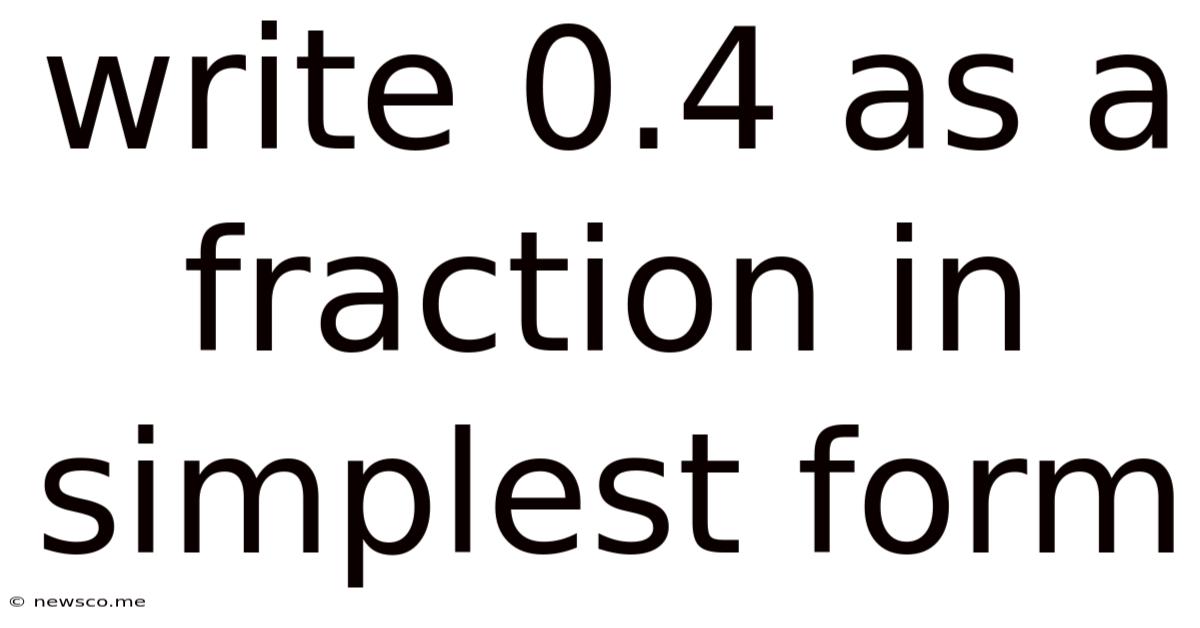Write 0.4 As A Fraction In Simplest Form
News Co
Mar 22, 2025 · 4 min read

Table of Contents
Write 0.4 as a Fraction in Simplest Form: A Comprehensive Guide
Are you struggling to convert decimals to fractions? Understanding this fundamental math concept is crucial for various applications, from baking to advanced engineering. This comprehensive guide will walk you through the process of converting the decimal 0.4 into its simplest fraction form, explaining the underlying principles and offering practical tips for similar conversions. We'll explore the method step-by-step, ensuring you fully grasp the concept and can confidently tackle similar problems in the future.
Understanding Decimals and Fractions
Before diving into the conversion, let's refresh our understanding of decimals and fractions.
Decimals: Decimals represent parts of a whole number using a base-ten system. The decimal point separates the whole number part from the fractional part. For instance, in 0.4, the '0' represents the whole number (there are no whole units), and '.4' represents four-tenths.
Fractions: Fractions represent parts of a whole using a numerator (the top number) and a denominator (the bottom number). The numerator indicates the number of parts you have, and the denominator indicates the total number of equal parts the whole is divided into. For example, 1/2 represents one out of two equal parts.
Converting 0.4 to a Fraction: Step-by-Step
The conversion process is relatively straightforward:
Step 1: Write the decimal as a fraction with a denominator of a power of 10.
Since 0.4 has one digit after the decimal point, we'll write it as a fraction with a denominator of 10:
0.4 = 4/10
Step 2: Simplify the fraction to its lowest terms.
To simplify a fraction, we need to find the greatest common divisor (GCD) of the numerator and denominator and divide both by it. The GCD is the largest number that divides both the numerator and the denominator without leaving a remainder.
In this case, the GCD of 4 and 10 is 2. Dividing both the numerator and the denominator by 2, we get:
4/10 = (4 ÷ 2) / (10 ÷ 2) = 2/5
Therefore, 0.4 expressed as a fraction in its simplest form is 2/5.
Expanding the Concept: Converting Other Decimals to Fractions
The method used for converting 0.4 can be applied to other decimals. Let's look at a few examples:
Example 1: Converting 0.75 to a fraction
- Write as a fraction: 75/100
- Find the GCD: The GCD of 75 and 100 is 25.
- Simplify: (75 ÷ 25) / (100 ÷ 25) = 3/4
Therefore, 0.75 = 3/4
Example 2: Converting 0.125 to a fraction
- Write as a fraction: 125/1000
- Find the GCD: The GCD of 125 and 1000 is 125.
- Simplify: (125 ÷ 125) / (1000 ÷ 125) = 1/8
Therefore, 0.125 = 1/8
Example 3: Converting 0.666... (repeating decimal) to a fraction
Repeating decimals require a slightly different approach. We'll explore this in more detail below.
Handling Repeating Decimals
Repeating decimals, such as 0.666..., present a unique challenge. Here's how to convert them to fractions:
Step 1: Let x equal the repeating decimal.
x = 0.666...
Step 2: Multiply both sides by 10 (or 100, 1000, etc., depending on the number of repeating digits).
10x = 6.666...
Step 3: Subtract the original equation from the new equation.
10x - x = 6.666... - 0.666...
This simplifies to:
9x = 6
Step 4: Solve for x.
x = 6/9
Step 5: Simplify the fraction.
The GCD of 6 and 9 is 3.
x = (6 ÷ 3) / (9 ÷ 3) = 2/3
Therefore, 0.666... = 2/3
Practical Applications of Decimal to Fraction Conversion
The ability to convert decimals to fractions is essential in numerous fields:
- Baking and Cooking: Recipes often require precise measurements, and converting decimals to fractions allows for more accurate ingredient proportions.
- Engineering and Construction: Precise calculations are paramount, and fractions are frequently used in blueprints and designs.
- Finance: Working with percentages and interest rates often involves converting decimals to fractions for easier calculations.
- Science: Many scientific calculations and measurements utilize fractions, especially in fields like chemistry and physics.
- Mathematics: A strong understanding of fractions and decimals is fundamental for advanced mathematical concepts.
Troubleshooting Common Mistakes
- Incorrect Simplification: Double-check your GCD calculation to ensure you've simplified the fraction to its lowest terms.
- Decimal Point Errors: Carefully note the number of decimal places when converting the decimal to a fraction.
- Repeating Decimal Errors: When dealing with repeating decimals, ensure you correctly multiply by the appropriate power of 10 and subtract the original equation.
Conclusion: Mastering Decimal to Fraction Conversion
Converting decimals to fractions is a fundamental skill with wide-ranging applications. By understanding the steps involved, practicing different examples, and paying attention to potential pitfalls, you can confidently master this essential mathematical concept. Remember, practice is key! The more you work through these conversions, the more comfortable and proficient you'll become. This will not only improve your mathematical skills but also enhance your problem-solving abilities in various aspects of life. Now go forth and conquer those decimal-to-fraction conversions!
Latest Posts
Related Post
Thank you for visiting our website which covers about Write 0.4 As A Fraction In Simplest Form . We hope the information provided has been useful to you. Feel free to contact us if you have any questions or need further assistance. See you next time and don't miss to bookmark.